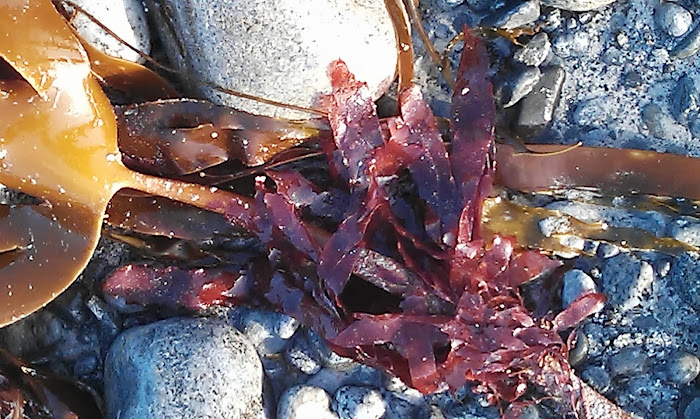It is a growing trend for the authors of seaweed
publication to note that amateur seaweed foragers tend to damage marine and
foreshore environments. Such books advocate that we ‘buy dried’ from
professional harvesters and or use seaweed infused in tracklements. I ask the
question why? Committed foragers are educated in the principles of best
foraging practice not least because they want to ensure continued growth for
the following season. Foragers may benefit from what is termed a Mast Year (when
there is a larger than average yield) but in other years of course there may be
a dearth. This variability cascades through the food chain and any forager has
to be sensitive to nature and mindful of passing seasons, the weather and its
effect on nature’s larder. The relatively newly formed
Association of Foragers has already produced an excellent code of conduct
Those harvesting wild seaweed commercially
do so, I hope, with similar care and concern; but they do it in larger
quantities and also for financial gain rather than for their own table. These seaweed-picking
squads are paid by the wet kilo and gather at spring (big) tides (after a new
or full moon). We all need to be careful whether picking or harvesting because
seaweed is a wild resource and one which we still know too little about. No
sooner is a seaweed text book in print than it is out of date. Indeed, my 2015
book “Seaweed in the Kitchen” is undergoing
a revamp over the next few months. Seaweed knowledge changes almost daily.
There has been a shift towards veganism
(360% in the last decade) and a genuine worry about too much dependence on
ruminants and their methane production. Living on South Uist I simply can’t buy
into this latest food fad. Succinctly, fruit trees simply won’t grow on the
hills where the surefooted sheep stamp out pathways through the bracken and
heather. The fact that the consumption of lamb has fallen will make little impression
on our crofters. It is the most productive way of farming northern hillsides.
Any Outer Hebridean tree that survives is often wind ‘styled’ and indeed restricted
to the sheltered eastern side. Rowan berries for making jelly may be tricky to
find out here but down at the coast where the water is startlingly clear there
is a profusion of seaweeds and they complement lamb. My preference is to use
dulse which some say tastes of bacon. Seaweed suits those on a vegetarian or
vegan diet but we need to embrace fresh seaweed and think sea-vegetable not just
expensive seasoning sprinklers which is what happens to most of the wild
seaweed ‘harvested’ in the UK.
 |
| The wings of Dabberlocks or Honeyware are delicious |
 |
Sea spaghetti or Thong Weed Salad
|
 |
Pepper dulse on chicken ready for roasting
|
My BBC Masterchef 2001 final recipe used wild
venison with wild ingredients - ones
that the magnificent red deer might have grazed upon. Ingredients which grow in
close proximity or that animals graze, often work well together in a
recipe. I started cooking with seaweed when
my husband became the Island doctor on South Uist, an outer Hebridean Isle with
few trees or bushes; but what it lacks in hedgerows, the Uists makes up for in
magnificent beaches. At low tide an ocean garden is revealed where I can gather
any amount of seaweed. Red, brown or green each seaweed has its unique flavour
and there are hundreds of species to choose from. My seaweed knowledge grows by
the day. Unlike with mushrooms toxicity isn’t a problem - but some taste yummier
than others.



